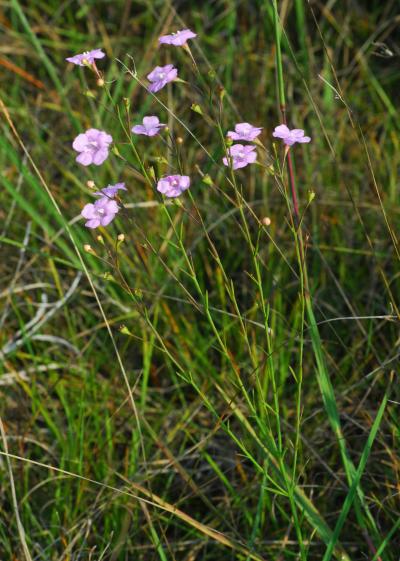Agalinis skinneriana (Alph. Wood) Britton
Midwestern Gerardia

Native
CC = 7
CW = 3
MOC = 20
© SRTurner
Agalinis skinneriana (Alph. Wood) BrittonMidwestern Gerardia | |
 |
Native CC = 7 CW = 3 MOC = 20 |
© SRTurner |
|
Family - Orobanchaceae Habit - Annual hemiparasitic forb. Stems - Ascending to erect, to 50 cm, usually branched in the upper 2/3 of the plant, sharply quadrangular, roughened with minute ascending hairs on the angles. Leaves - Opposite, simple, sessile, stiff and ascending, linear, entire, roughened, lacking axillary fascicles.
Inflorescence - Narrow to open racemes at branch tips. When fully open, flowers appear to face upward.
Calyx - Calyces 2.5-4.5 mm long, broadly bell-shaped, about as long as wide at flowering, the thickened, triangular lobes 0.5-1.2 mm long, much shorter than the tube, glabrous or nearly so, the sinuses between the lobes at flowering broadly U-shaped.
Flower - Corollas 8-16 mm long, pink, the tube glabrous or nearly so, the throat with purplish spots, pubescent with relatively long, multicellular hairs at the base of the upper lobes, the lobes glabrous on the outer surface, the upper two lobes spreading to bent backward at full flowering.
Fruits - Globose, 3.5-5.5 mm, glabrous.
Flowering - July - October. Habitat - Glades, upland prairies, bluff tops. Origin - Native to the U.S. Lookalikes - Broadly, several other species of Agalinis. Other info. - This species is relatively uncommon, though it can be locally abundant. In Missouri it is found mostly in southeastern and southwestern counties. Beyond Missouri its natural range includes only a few other states, where it is generally uncommon. The upward-facing flowers are a key attribute for identification in the field. The two upper corolla lobes are spreading to reflexed. Often growing on relatively poor substrates, the plants are relatively slender and few-branched, less bushy than the more common A. tenuifolia and A. gattingeri. Photographs taken at Valley View Glade Natural Area, Jefferson County, MO, 8-24-2015, and at Victoria Glade, Jefferson County, MO, 8-31-2015 (SRTurner). |